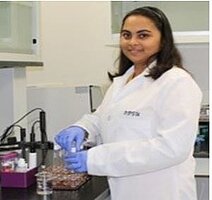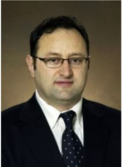UV Light Effect on Bioavailability of Dissolved Organic Nitrogen in a Trickling Filter Process

Swati Sharma
Fellow: Swati Sharma
Adviser: Halis Simsek
UV Light Effect on Bioavailability of Dissolved Organic Nitrogen in a Trickling Filter Process
Dissolved organic nitrogen (DON), a complex structure, in wastewater has been a major environmental concern especially for receiving waters. Understanding the biodegradability (BDON) and bioavailability (ABDON) characteristics of wastewater derived DON is important to achieve successful removal of DON from anthropogenic sources using bacterial and algal inocula. The purpose of this study is to evaluate the impact of hydraulic retention time on biodegradability and bioavailability of wastewater derived DON using integrated two moving bed biofilm reactors (MBBRs). The MBBR media (plastic white media, about 1 inch in diameter) are used in the reactors to support the growth of bacteria and algae. Various hydraulic retention times (HRTs) at 1, 3, and 6 days have been investigated on primary effluent samples collected from the city of Fargo wastewater treatment plant (WWTP). The samples are further incubated in batch reactors with bacteria and alga + bacteria for 21 days to investigate the utilization of bio-available/degradable DON. A significant reduction in DON has been observed when the reactors are run at an HRT of 3 days.
In the second phase of the experiments, the samples were collected from the second MBBR reactor exposed to UV light to determine photodegradable DON (PDON) and further incubated to determine photo biodegradable DON (PBDON) and photo bioavailable DON (PABDON). For the experiments, 500 ml of samples from reactor-2 effluent was transferred into a quartz flask and two 40 watt and 254 nm wavelength of UV lamps were used to irradiate the samples continuously for 6 days. PDON values were determined after UV light exposure and the samples were further incubated for 21 days to determine PBDON and PABDON.
Significance of Research:
This research provided a comprehensive data to address nutrient contamination introduced to surface waters in North Dakota. Using algae and bacteria in a chemostat reactor to determine BDON and ABDON is a new approach. Additionally, the effect of UV light on bioavailable 31 DON (PABDON) to algae + bacteria has not been studied in wastewater treatment processes including trickling filter process. The findings of this research were presented at national and/or regional conferences and will be submitted for publication in a peer review journal. A final report containing all the information on the project including raw data will be delivered at the end of the project.
Significant Findings:
The optimum removal of organic nitrogen can be achieved at an average HRT of 3 days. About 40% of DON was bioavailable to bacteria and algae. Lower HRTs may result in inefficient removal whereas HRTs higher than 6 days could result in low nutrient uptake and cell lysis. From the algae + bacteria seeded samples, it can be understood that wastewater derived DON in receiving waters can be taken up by algae in the presence of bacteria. This facilitates our conclusion that algae can uptake higher level of wastewater derived DON in receiving waters in the presence of bacteria. The photodegradability of DON using UV light has been conducted in batch study to understand the fate of DON when exposed to UV light continuously for 6 days. Results showed that, using UV light to the reactor effluents can further degrade DON to a significant level. Thus, working towards reduction in the level of DON should be considered a primary concern in the treatment plants before its discharge to the receiving water bodies.
Publication
Sharma, S.; D.L. Tucker; H. Simsek, 2016, Wastewater Derived Dissolved Organic Nitrogen Removal Using Integrated System of Biological Reactors and UV Light Irradiation, in Proceeding 89th Annual Water Environment Federation Technical Exposition and Conference, Water Environment Federation, Alexandria, VA.

Halis Simsek
AES Ag & Biosystems Eng
Office: ABEN 2016
Phone: 701-231-6107
Email: halis.simsek@ndsu.edu


